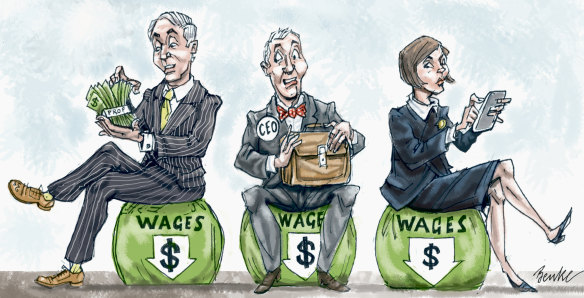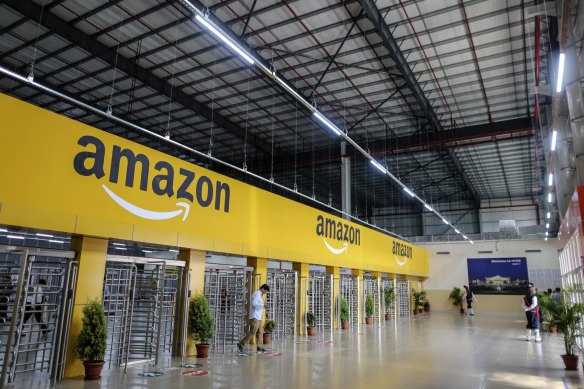This was published 2 years ago
Opinion
Ever wondered why your wages aren’t rising?
Ross Gittins
Economics EditorIt’s dawning on people that when the competition between businesses isn’t strong, firms can raise their prices by more than the increase in their costs, and so fatten their profit margins. What’s yet to dawn is that weak competition also allows businesses to pay their workers less than they should.
In standard economic theory, it’s the intense competition between firms that prevents them from overcharging for their products and earning more than a “normal” profit.

Credit:
Normal profit gives the owners of the firm just sufficient return on the capital they’ve invested to stop them leaving the industry and trying their luck elsewhere.
The theory assumes the industry has numerous firms, each one too small to influence the market price. In today’s world, however, many markets are dominated by just two, three or four huge firms.
These firms are big enough to influence the market price, especially when it’s so easy for them to collude tacitly with their rivals.
We see the four big banks doing this every time interest rates are raised. They have an unspoken agreement not to compete on price.
When a firm has a large share of the industry’s employment, the gap between the value of the work a worker does, and the wage they’re paid in return, tends to grow.
I say they have “pricing power”, but many economists say they have “monopoly power”. How can a handful of firms have monopoly power? Because economists don’t use that term literally. On a scale of one to 1000 firms, we’re right down the monopoly end.
Dr Andrew Leigh, the Assistant Minister for Competition, and a former economics professor, has been giving a series of speeches about recent empirical studies on how competitive our markets are.
In one, he quoted the findings of Jonathan Hambur, a researcher who pivots between Treasury and the Reserve Bank, that Australian firms’ “mark-ups” – the gap between their cost of production and their selling price – have been rising steadily.
But in a further speech this month, Leigh turned the focus from what “market concentration” (among a few massive companies) means for the industry’s customers, to what it means for its employees.
So, in econospeak, we’re moving from monopoly to “monopsony”. Huh? Taken literally, monopoly means a market in which there’s a single seller meeting the demand for the product. Monopsony means there’s a single buyer from the people supplying the inputs to production. Workers supply the firm with the labour it needs.
The term was introduced by Joan Robinson, a colleague of Keynes at Cambridge, who was among the first to question the standard theory of how markets work. She was 30 in 1933 when she published her dissenting view that truly competitive markets were rare.
She argued that monopsony was endemic in the labour market and employers were using it to keep wages low. If there are few employers competing for workers, those workers have fewer “outside options” (to move to another firm offering higher pay or better conditions).
This limits workers’ bargaining power and gives employers the power to keep wages lower.

Amazon was accused of using monopsony power in its warehouses to depress wages in local markets.Credit: Dhiraj Singh
At the time, few economists took much interest. But in recent years there’s been a growing focus on market power by academic economists.
For instance, monopsony was cited in a US Supreme Court ruling against Apple in 2019. A report by Democrats in the US House of Representatives accused Amazon of using monopsony power in its warehouses to depress wages in local markets.
Evidence from the US, Britain and Europe has demonstrated that increases in labour market concentration – fewer employers to work for – are associated with lower wages.
Leigh says economists have long known that people in cities tend to earn more than those in regional areas. His own research found that when someone moves from a rural area to a major Australian city, their annual income rises by 8 per cent.
“The economics of monopsony suggests that an important part of the urban wage premium can be explained by greater employer competition in denser labour markets,” Leigh says.
Leigh reminds us that Australia’s average full-time wage ($1808 a week last November) was only $18 a week higher than it was 10 years ago, after allowing for inflation. Many things would explain this pathetic improvement, but one factor could be employers’ monopsony.
We know that the rate at which people move between employers has fallen. But over a person’s working life, the biggest average wage gains come when people switch employers. And when some people leave, the bargaining power of those who stay is increased.
This decline in people moving could be caused by increased employer monopsony. Hambur has done a study of employment concentration between 2005 and 2016.

Increases in labour market concentration are associated with lower wages.Credit: Louie Douvis
He found that, within industries where concentration rose, growth in real wages over the decade was significantly lower.
When a firm has a large share of the industry’s employment, the gap between the value of the work a worker does, and the wage they’re paid in return, tends to grow.
He found that employment in regions close to major cities is twice as concentrated as in the cities. In remote areas it’s three times.
Read this carefully: Hambur found that labour markets had not become more concentrated over the decade. But at every degree of concentration, its negative impact on wages had more than doubled.
So, employers’ market power could well be a factor helping to explain the virtual absence of real wage growth over a decade. Hambur finds that the greater impact of employer concentration may have caused wage growth between 2011 and 2015 to be 1 per cent lower than otherwise.
This would help explain why not all the (weak) growth in the productivity of labour during the period was passed through to real wages – as conventional economists and business people always assure us it will be. Weak competition allowed employers to keep a lot of it back for themselves.
Part of the competitive process is new firms entering the industry. New firms usually poach staff away from the existing firms. But we know the rate of new entry has declined.
Ross Gittins is the economics editor.
The Business Briefing newsletter delivers major stories, exclusive coverage and expert opinion. Sign up to get it every weekday morning.